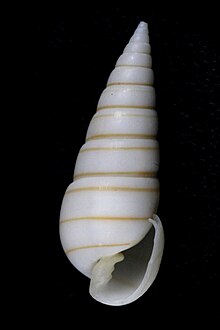Pyramidella dolabrata
| Pyramidella dolabrata | |
|---|---|

| |
| Shell of Pyramidella dolabrata Linnaeus, 1758, measuring 31.1 mm in height collected in beach drift on shore in Philipsburg, in St. Maarten. | |
| Scientific classification | |
| Kingdom: | |
| Phylum: | |
| Class: | |
| (unranked): | |
| Family: | |
| Subfamily: | |
| Tribe: | |
| Genus: | |
| Species: | P. dolabrata
|
| Binomial name | |
| Pyramidella dolabrata Linnaeus, 1758
| |
| Synonyms[1] | |
| |
Pyramidella dolabrata, common name the "giant Atlantic pyram", is a somewhat variable species of small to medium-sized (max size 36 mm) sea snail, a marine gastropod mollusk in the (mostly minute) family Pyramidellidae, the pyram snails. [2]
Subspecies
- Pyramidella dolabrata terebellum (Müller, 1774)[1] (synonym: Pyramidella terebellum Muller, 1774)
Distribution
This species is found in shallow water in the tropics of the Western Atlantic Ocean, ranging from Florida through the mainland Caribbean and the West Indies south to Brazil, and also in the Eastern Atlantic Ocean at Saint Helena.[1]
Description
The white shell has three or four narrow chestnut spiral lines on the body whorl, and two on the whorls of the teleoconch. The shell is smooth and umbilated. The outer lip often lirate within. The length of the shell varies between 14 mm and 36 mm. [4] The maximum recorded shell length is 36 mm.[5] Pyramidella dolabrata possesses a complicated series of columellar folds.
Anatomy
The complete nucleotide sequence of the mitochondrial genome of Pyramidella dolabrata has been available since 2008.[6]
Distribution
This marine species has a wide distribution. It has been recorded in
- The Caribbean Sea, the Gulf of Mexico, the Lesser Antilles
- The Atlantic Ocean off the Cape Verdes, St. Helena, Sao Tomé and Principe, Angola, West Africa
- The Indian Ocean : off Madagasar, Mauritius
- The Indo-Pacific Region.
Habitat
The minimum recorded depth for this species is 0 m.[5] The maximum recorded depth is 57 m.[5]
References
- ^ a b WoRMS (2010). Pyramidella dolabrata (Linnaeus, 1758). Accessed through: World Register of Marine Species at http://www.marinespecies.org/aphia.php?p=taxdetails&id=208421 on 2011-03-15
- ^ Bouchet, P. (2014). Pyramidella dolabrata (Linnaeus, 1758). Accessed through: World Register of Marine Species at http://www.marinespecies.org/aphia.php?p=taxdetails&id=208421 on 2015-02-07
- ^ Oliveira, M. P.; Rezende G. J. R.; Coelho L. F. (1975). "Contribuição ao conhecimento da malacofauna de Angola". Boletim do Instituto de Ciências Biológicas e Geociências (in Portuguese) (10). Brazil: UFJF: 1–17.
- ^ G.W. Tryon, Manual of Conchology vol. VIII p. 300; 1889
- ^ a b c Welch J. J. (2010). "The "Island Rule" and Deep-Sea Gastropods: Re-Examining the Evidence". PLoS ONE 5(1): e8776. doi:10.1371/journal.pone.0008776.
- ^ Grande C., Templado J. & Zardoya R. 2008. Evolution of gastropod mitochondrial genome arrangements. BMC Evolutionary Biology 2008, 8:61. doi:10.1186/1471-2148-8-61

